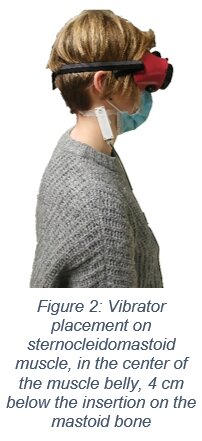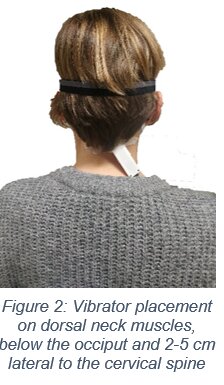Can neck vibration affect postural control?
Postural control is one of the most important functions of the human body. The main goal of postural control is to keep the body in an upright and stable position. For this reason, even simple daily tasks cannot be performed without efficient postural control [1]. In order to have an efficient postural control, a combination of input from the visual, vestibular and proprioceptive system is used [2,3]. The three system are connected via direct neural connections in the brainstem area [4], and in the central cervical nucleus [5].
The neck proprioception
The proprioceptive system uses input from mechanoreceptors, such as muscle spindles [6]. Changes in the input from muscle spindles can therefore change a person’s postural control [7-9]. The most important areas involved in providing proprioceptive input to maintain postural control are the lower leg and the cervical spine area, due to the high number of spindles present in these areas. Especially in the cervical spine, the proprioceptive system is extremely developed, due to a high density of spindles, mainly the γ-muscle spindles in the deep segmental upper cervical muscles [10]. The rectus capitis posterior contains 98 spindles per gram of muscle [11]. The role of these neck muscle spindles is twofold: first, to provide afferent proprioceptive information about the postural control, and second, to provide significant details to the central nervous system concerning the position of the head in relation to the rest body [4].

Changes in neck proprioception
In studies investigating the influence of neck dysfunction on balance, neck muscle vibration is frequently applied to disturb the cervical proprioceptive input [12]. A lot of different vibrations frequencies (80 Hz, 100 Hz and 150 Hz the most commons), and different locations were used (sternocleidomastoid, dorsal neck muscles and trapezoid muscle). Until now it is not clear which vibration frequency and location cause the biggest effect on the postural sway. For this reason, we performed a cross sectional study and a systematic review to answer these questions. The results of these studies will be announced soon.

Clinical practice and future directions?
Generally, neck pain reduces neck proprioception, and cause a lot of problem on these patients. Neck vibration can be easily used, also in clinical practice as a proprioception training technique. Until now we don’t have a lot of studies that used neck vibration as a proprioception improvement technique. So, it is very important new studies try to find the effect of vibration on these patients or in patients with postural sway problems.
Written by Antonios Chalimourdas, PhD student
*Photos are personal property of Antonios Chalimourdas